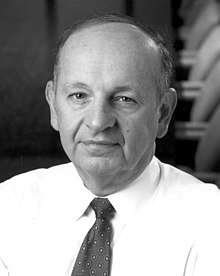George H. Heilmeier
George Harry Heilmeier (born May 22, 1936 in Philadelphia , Pennsylvania , † April 21, 2014 in Plano , Texas ) was an American electrical engineer and manager who contributed significantly to the development of liquid crystal displays .
Life
Heil Meier received his BS as an electrical engineer at the University of Pennsylvania in Philadelphia, and his MSE - MA - and Ph.D. - Degrees in semiconductor engineering and electronics from Princeton University .
1958 joined Heil Meier at the RCA Laboratories in Princeton , New Jersey , one where he attended parametric amplifiers, tunnel diodes - down converters , millimeter wave generators, ferroelectric thin film -Bauelementen, organic semiconductors , and electro-optical effects of crystals and liquid crystals (Engl. Liquid Crystals ) worked . In 1964, together with Williams, he discovered various new electro-optical effects on liquid crystals, which led to the development of the first liquid crystal displays based on what he called Dynamic Scattering Mode (DSM). In addition, the so-called guest-host effect with embedded color molecules was also tested in his team .
In the 1970s, Heilmeier worked primarily for the US Department of Defense . In 1970/71 he served as a White House Fellow and personal assistant to the Secretary of Defense , planning long-term research projects. In 1971 he was appointed Assistant Director for Defense Research and Engineering, Electronic and Physical Sciences , responsible for all research and development activities in the field of electronics and physics. In 1975 he became director of the Defense Advanced Research Projects Agency (DARPA), where he initiated pioneering developments, particularly in stealth technology , space-based laser and infrared systems, and in the field of artificial intelligence .
In December 1977, Heilmeier left the Department of Defense to become Vice President of Texas Instruments , and in 1983 he was promoted to CTO . From 1991 to 1996 he was President and CEO of Bellcore (now Telcordia Technologies ) and ultimately accompanied the sale to Science Applications International Corporation (SAIC). He was Chairman and CEO of the company from 1996 to 1997.
Heilmeier received a large number of honors. He held 15 patents and was a member of the National Academy of Engineering , the Defense Science Board, and the National Security Agency Advisory Board . He has served on the Advisory Boards of Fidelity Investments and Teletech Holdings, and on the Advisory Board of the School of Engineering and Applied Science at the University of Pennsylvania.
"Heilmeier's Catechism"
Heilmeier is assigned a set of questions that everyone should be able to answer who proposes a research project or product development.
- What you up to? Describe your project without using jargon.
- How has it been done so far and what are the limits of current practice?
- What's new about your approach and why do you think it will be successful?
- Who cares?
- If you are successful, what difference will it make?
- What are the risks and what are the benefits?
- How much will it cost?
- How long it will take?
- How can you measure success in the course of the project and at the end of it?
Selected honors and prizes
- 1976 IEEE David Sarnoff Award , IEEE
- 1990 C&C Prize, NEC
- 1991 National Medal of Science , USA
- 1992 National Academy of Engineering Founders Award , USA
- 1993 IRI Medal from the Industrial Research Institute , USA
- 1995 admission to the American Academy of Arts and Sciences
- 1996 John Scott Award , City of Philadelphia
- 1997 IEEE Medal of Honor , IEEE
- 1999 John Fritz Medal , American Association of Engineering Societies
- 2005 Kyoto Advanced Technology Prize, Inamori Foundation
- 2006 Edwin H. Land Medal , Optical Society of America
- 2012 Charles Stark Draper Prize , National Academy of Engineering
Selected publications
- R. Williams: Possible Ferroelectric Effects in Liquid Crystals and Related Liquids. In: Journal of Chemical Physics 44 (1966), p. 638.
- with LA Zanoni and LA Barton: Dynamic Scattering: A New Electrooptic Effect in Certain Classes of Nematic Liquid Crystals. In: Proceedings of the IEEE 56 (1968), p. 1162.
- Liquid crystal display devices. In: Scientific American 222 (1970), p. 100.
- Liquid Crystal Displays: An Experiment in Interdisciplinary Research that Worked. In: IEEE Transactions on Electron Devices , ED-23 (1976), p. 780.
Web links
- Interview with George H. Heilmeier , Charles Babbage Institute , University of Minnesota (English). Heilmeier describes his time at the US Department of Defense, mainly his years as director of the Defense Advanced Research Projects Agency (1975–1979).
- IEEE biography (Engl.)
- Inamori Foundation biography (Engl.)
Individual evidence
- ^ William Yardley: George H. Heilmeier, an Inventor of LCDs, Dies at 77. In: The New York Times, May 6, 2014 (English, accessed May 12, 2014).
- ^ Benjamin Gross: How RCA lost the LCD. In: IEEE Spectrum, Vol. 49, No. 11 (November 2012), p. 49.
- ↑ Panel on Building and Fire Research, National Research Council: An Assessment of the National Institute of Standards and Technology Building and Fire Research Laboratory, quoted G. Heilmeier: Some Reflections on Innovation and Invention. Founders Award Lecture, National Academy of Engineering, Washington, DC, Sept. 1992.
- ↑ John Scott Award Recipients 1991-2000 . John Scott Award Advisory Committee. Retrieved November 27, 2012.
- ↑ http://www.osa.org/aboutosa/awards/osaawards/awardsdesc/edwinland/
| personal data | |
|---|---|
| SURNAME | Heilmeier, George H. |
| ALTERNATIVE NAMES | Heilmeier, George Harry |
| BRIEF DESCRIPTION | American engineer and businessman |
| DATE OF BIRTH | May 22, 1936 |
| PLACE OF BIRTH | Philadelphia , Pennsylvania |
| DATE OF DEATH | April 21, 2014 |
| Place of death | Plano , Texas |
